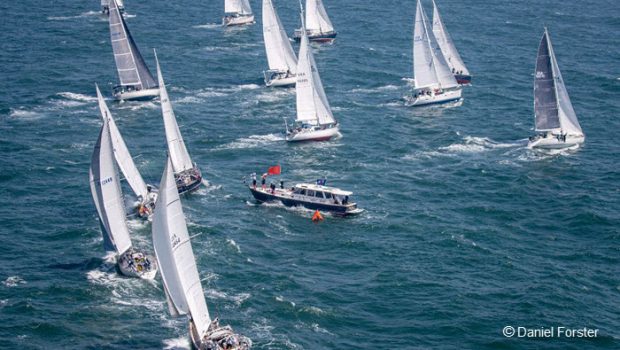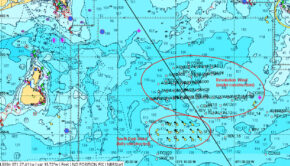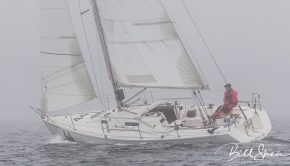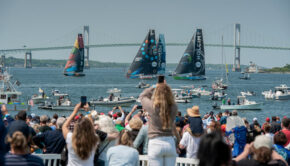Hectic start for Newport Bermuda Race
Published on June 17th, 2022
Newport, RI (June 17, 2022) – At approximately 1642 hours this afternoon, Christopher Stanmore-Major’s Gran Mistral 80 Osprey entered the course of the Newport Bermuda Race and drew to a close one of the most unusual starts to the race in recent memory.
The first classes started in a 22-knot southwesterly in a ripping ebb tide, followed by a brief influx of dense fog, a period of sunshine, and then a line of soaking thunderstorms that halted the starting procedure.
By the time the last three classes got underway on the backside of the line, the last classes could barely get across the starting line. Fortunately, the ebb tide out of Narragansett Bay was still pushing the fleet toward Bermuda.
“Overall, those were some of the best conditions I’ve seen for the start in the last five or six Bermuda Races,” said Clare Harrington, the principal race officer for the start of the race and the Rear Commodore of the New York Yacht Club.
“Having all that wind at the beginning from the southwest was spectacular. I think it was ideal conditions. When that front came through it was a little dicey. I don’t recall ever having to put the start on hold like that to let that thunderstorm go by. That was new.”
Antoine Rabaste’s (Nimes, France) VPLP 80-foot trimaran Ultim’Emotion2 took the early lead in the race for line honors, but at approximately 1900 hours reported to the Bermuda Race Fleet Communications that it had dropped their rig. Initial reports were that all crew were reported well.
The trimaran had already sailed more than 120 nautical miles of the course and was leading Jason Carroll’s (New York City) MOD70 Argo by approximately 10 miles.
The first start for the fleet of 187 sailing yachts occurred as scheduled at 1310 hours, with Martin Sutter’s 141-foot superyacht Columbia and the three-masted Spirit of Bermuda taking the start.
Next up, 10 minutes later, were the two trimarans, Argo and Ultim’Emotion2, joined by 11th Hour Racing’s IMOCA 60 Mālama, skippered by Charlie Enright. Argo set a particularly fast pace across the line, with its starboard float clearing the committee boat by mere feet as it sped onto the racecourse. It seemed like only five minutes later when Argo was crossing tacks with Spirit of Bermuda.
Many of the class starts, including those in the Double-Handed, Finisterre, and St. David’s Lighthouse divisions, were held in a gusty southwesterly that piped up to 23 knots on the committee boat. Coupled with the ebb tide running at close to 4 knots, the entrance to the East Passage of Narragansett Bay was a choppy mess. The tide was so strong that it turned the committee boat nearly 180 degrees to the strong wind.
Despite the tide sweeping the racers up the course, there were only a handful of boats starting early and no one hit the committee boat, even though the approach to the line was, at times, broadside to the committee boat.
Most of the good starts were had by the crews that could win the boat end. They would reach along and then harden up once clear of the bow of the committee boat. Such starts were had by Andy Burton’s (Newport, Rhode Island) Baltic 47 Masquerade in Class 8, Beau Van Metre’s (Middleburg, Virginia/ Newport, Rhode Island) 59-footer Running Tide in Class 9 and Stan and Sally Honey’s (Palo Alto, California) Cal 40 Illusion in Class 10.
After the Class 10 start, a fog bank rolled in that reduced visibility to about a half mile. But it only lasted through the start of Class 11, and then lifted to glorious weather until the squall line approached.
At 1455 the National Weather Service issued a severe thunderstorm warning for the greater Newport area. Harrington and her crew pressed on through the start of Class 16 at 1520 hours, when the threat of lightning became too great to continue. One thing there’s a lot of on the committee boat is aluminum poles for the many signal flags needed, so prudence was the call of the moment.
The postponement lasted between 30 and 40 minutes, and when the sequence resumed the wind had shifted to the northwest, at around 8 to 10 knots. Class 17, the final St. David’s Lighthouse Division class, saw many competitors hoist asymmetric headsails sails or reaching gennakers.
After that a heavy rain squall crossed the starting area and completely shut down the breeze. The final two starts, both for the Gibbs Hill Lighthouse Division boats, were light-air affairs, particularly for Class 19, the final class.
Luckily for Osprey the tide was still ebbing because it was caught well below the start line when the starting signal sounded. It would be close to 10 minutes before Osprey cleared onto the course.
Event information – Race details – Entry list – Tracker
The 52nd running of the Newport Bermuda Race, co-organized by the Cruising Club of America (CCA) and the Royal Bermuda Yacht Club (RBYC), began Friday, June 17, 2022 at the entrance to the East Passage of Rhode Island’s Narragansett Bay.
First run in 1906, the Bermuda Race is the oldest of the five great 600-nautical mile races and is preceded only by the Transatlantic Race. The 2022 fleet has 187 entrants which will be split among eight divisions: Double-handed, Finisterre (for cruisers), Gibbs Hill Lighthouse, Multihull, Open, Spirit of Tradition, St. David’s Lighthouse and Superyacht.
The record within the major divisions—St. David’s Lighthouse (limits on pro crew) and Gibbs Hill Lighthouse (no limits)—is 39 hours and 39 minutes, set by George David’s maxi yacht Rambler 90 in 2012, an average speed of 16 knots.
Source: CCA









 We’ll keep your information safe.
We’ll keep your information safe.